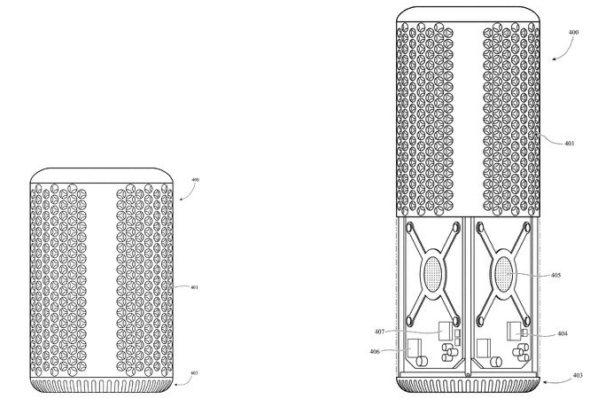Apple is looking to expand the premium mesh design of the device Mac Pro For 2019, or what is known as a cheese grater, to include other devices, including the iPhone and Mac Pro, similar to the "trash bin", according to a new patent.

Apple introduced an innovative aluminum mesh pattern on the Mac Pro and the XDR Pro screen in 2019. The result is a lightweight, solid-build design that maximizes airflow.
The new patent is titled "Housing construction" and Apple intends to expand it to include other devices, such as the iPhone.

The patent states that 'recent developments in electronic devices have enabled high levels of performance, but many current formulation solutions are unable to effectively distribute or reduce the heat generated by the electronic device, thus reducing the performance levels of these devices.
Apple believes that its mesh pattern provides a solution to this problem, as it increases the surface area of the device for better cooling and can more effectively transfer heat away from a component of the electronic device placed large and close to the surface of the body.
The illustrations included in the file show how to integrate a miniature version of the grid pattern directly into the outer and back frame of an iPhone.

These enhanced levels of heat dissipation, as described above, can not significantly improve the performance of the electronic device and may allow the use of components and technologies not yet used.
With improved cooling, mesh-style devices can increase the processor temperature for better performance.
In addition to greatly improving the heat, this can also tighten the structure, provide a unique and pleasant look and feel, and give a pleasant experience when handling the device.
The patent says:
In some cases, the XNUMXD structure can include a relatively complex pattern which, in addition to enhancing heat dissipation capabilities and providing rigidity, provides an aesthetically interesting effect to the user. This three-dimensional structure, for example when used in this fashion, can include a variety of colors in one or more areas to improve the visual appearance and provide a pleasant aesthetic experience for the user.
Another advantage of the grid pattern is the improvement of structural strength without increasing the thickness or weight of the components.

When using this design, it can provide a high level of strength and rigidity to the weight ratio of the machine. Conventional structures often achieve rigidity by thickening or enlarging certain parts of the structure, which often leads to an increase in the weight and size of the electronic device, which may not be desirable to the user. The XNUMXD structures here could, for example, include an array of walkways that greatly enhance the rigidity of the three-dimensional structure, without significantly increasing the size or weight of the structure. Thus, a relatively lightweight, but very strong and rugged electronic device can be produced.
Another model covers the inclusion of the internal network inside the "iPhone" to improve rigidity and strength, which allows the "electronic device to be used for a long period of time while maintaining dimensional stability."
The patent also mentions how the lattice structure can act as a shield for an electronic device while still allowing air to flow through it, in particular as a shield against electromagnetic interference (EMI) or electromagnetic compatibility (EMC) noise.
In addition to the iPhone, Apple appears to have revived the controversial 2013 Mac Pro design, unofficially dubbed the Trashcan Mac Pro, to show alternative incarnations of the grille.

Since the grille mode debuted on the 2019 Mac Pro, it is interesting to see some of the latest aspects of Mac Pro design applied to an older model.
Although a return to Trash-style design may seem more likely in the midst of the move to Apple silicon for the next generation Mac Pro, the machine is actually expected to look more like a Mac mini.
Like patents, they are not strong evidence of its adoption of future devices, but they give us an idea of how the company thinks and how advanced its fields of research are, and the company may plan to actually bring these technologies into one of its future devices.
Source:



16 comment